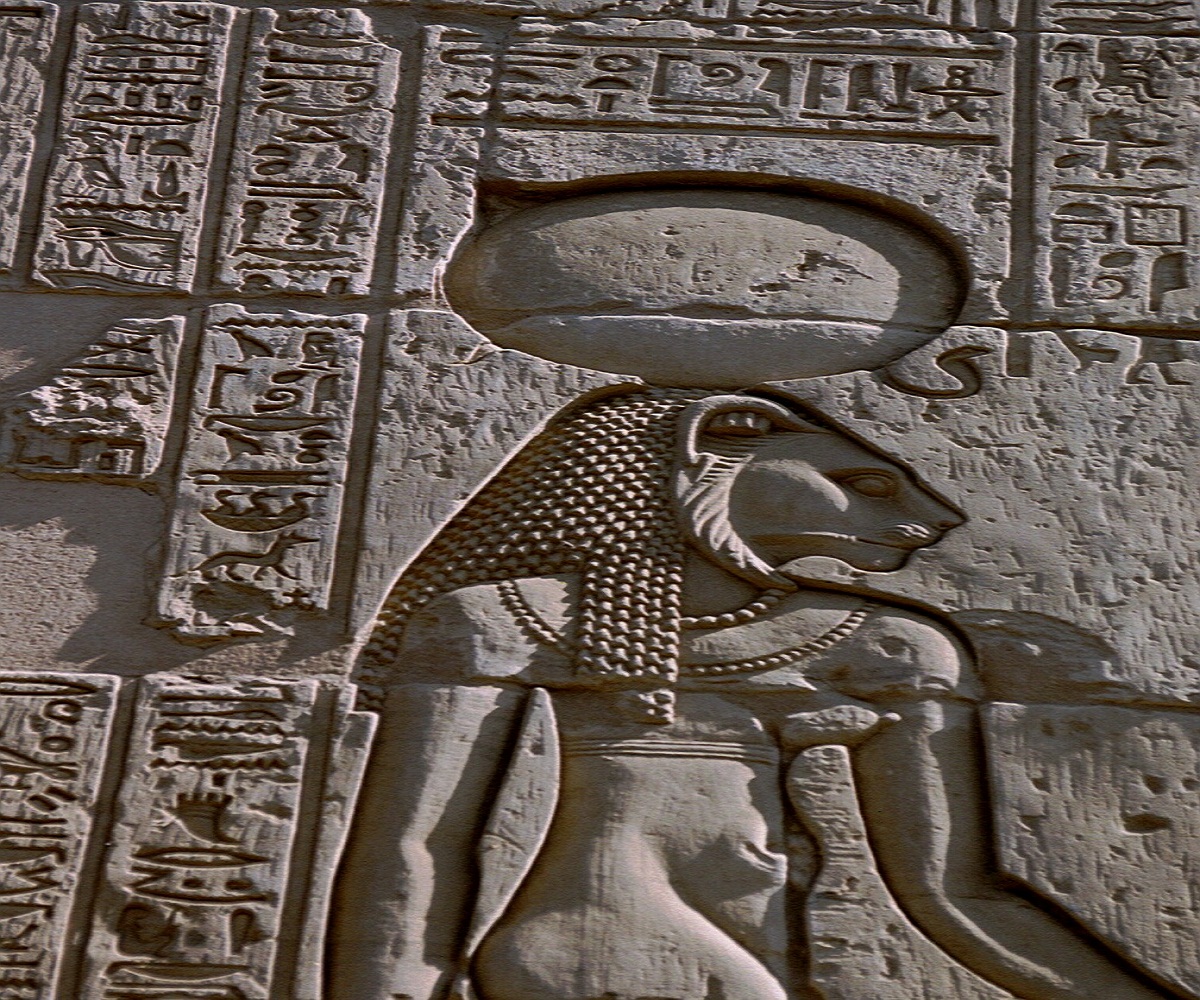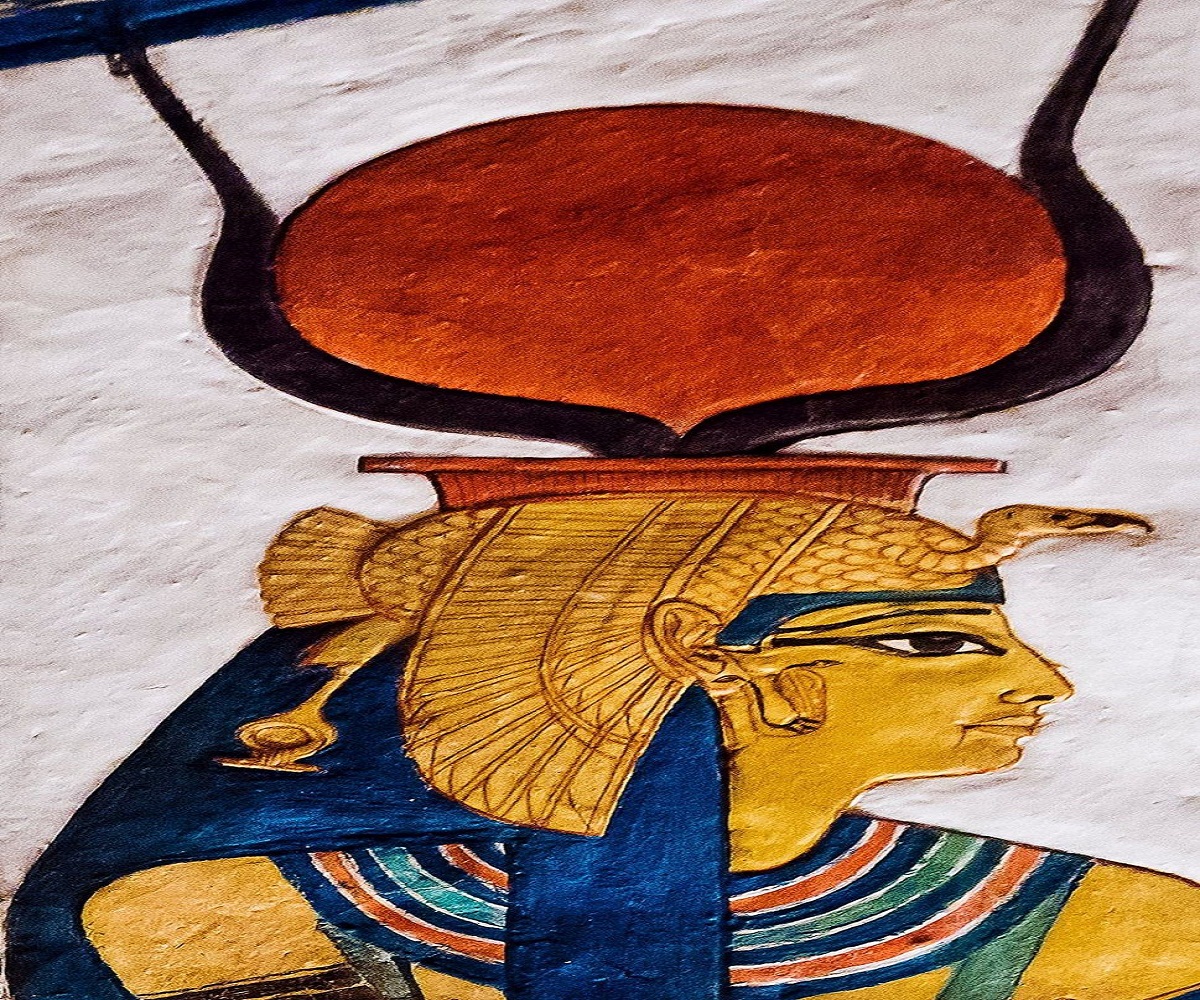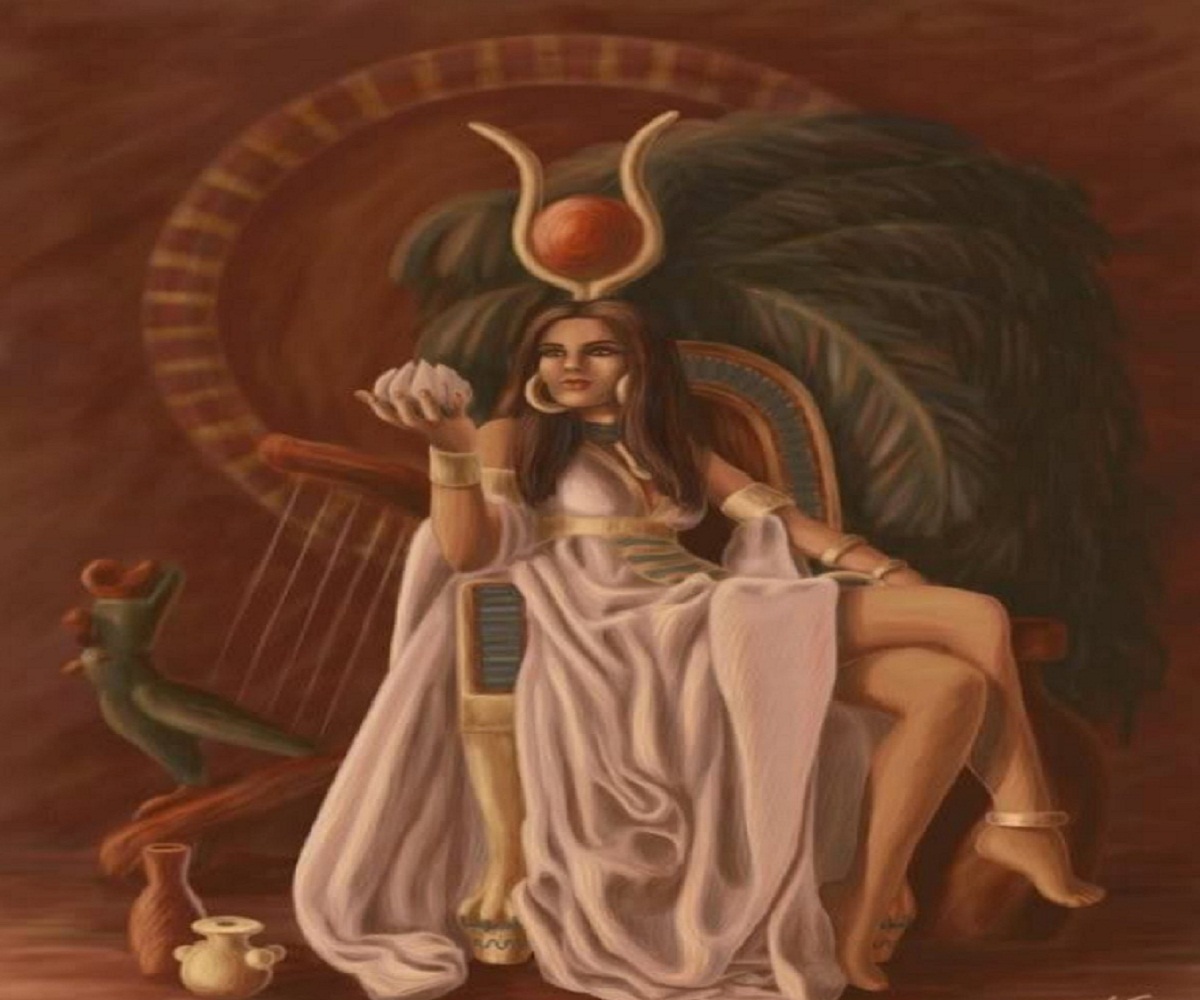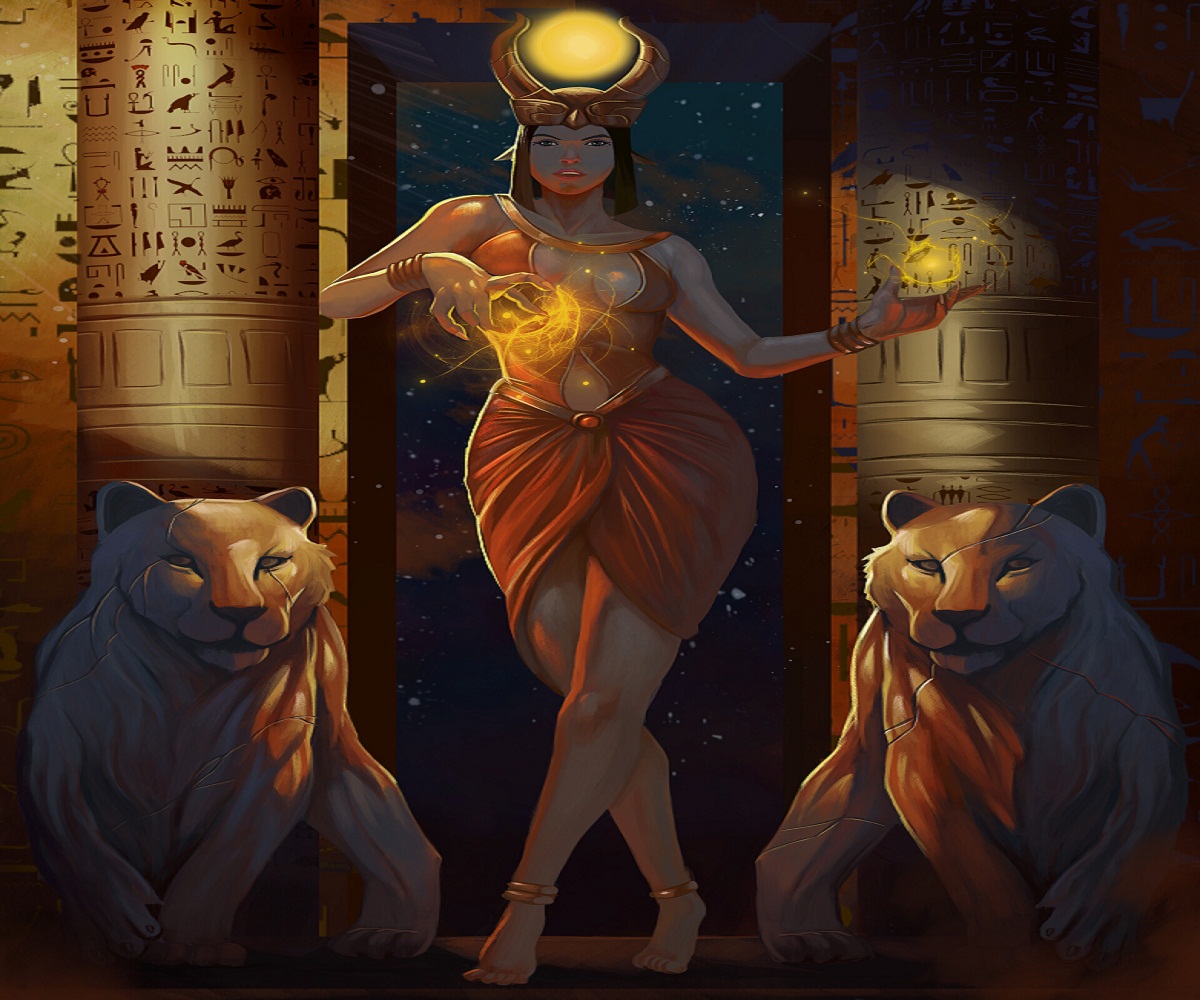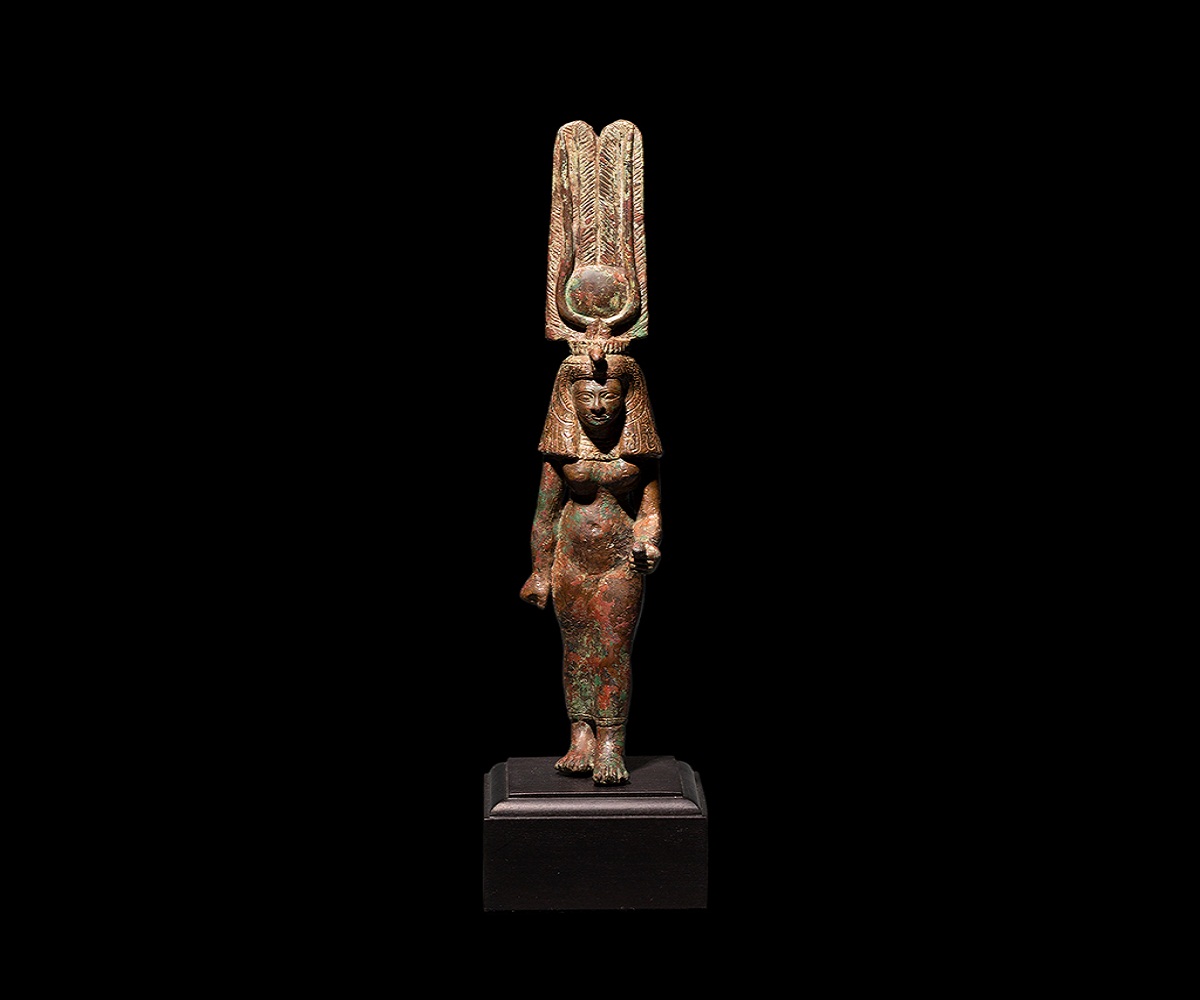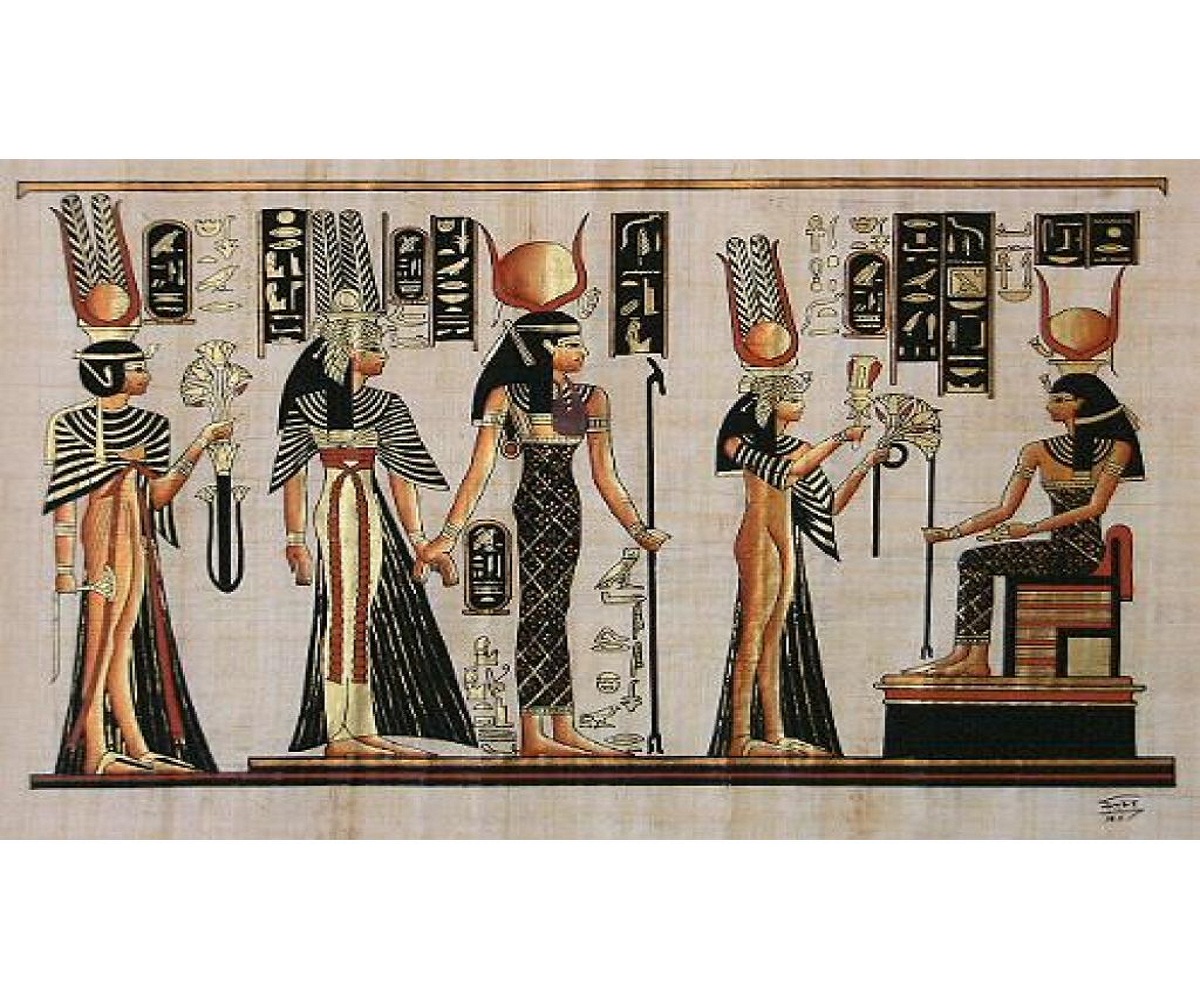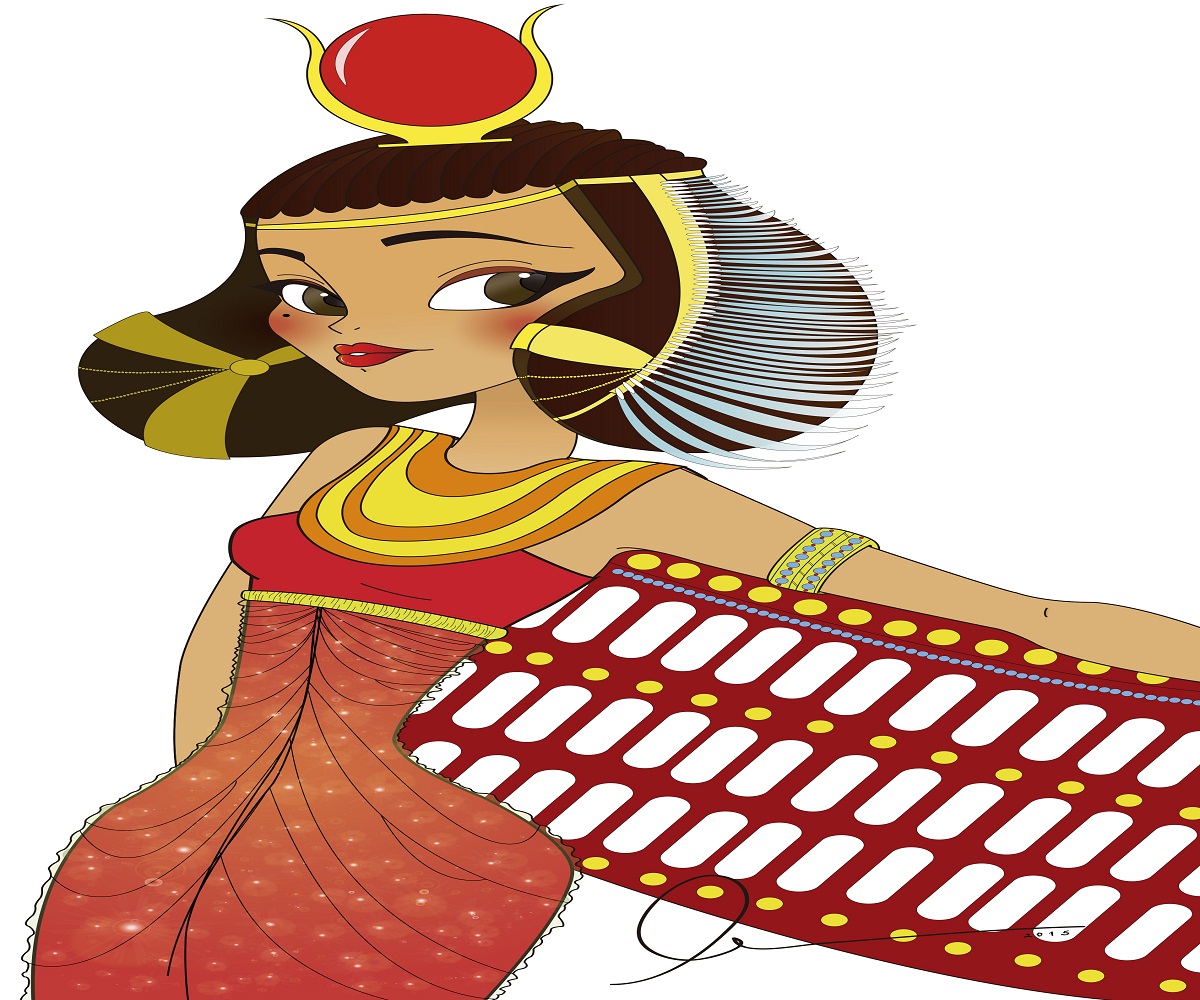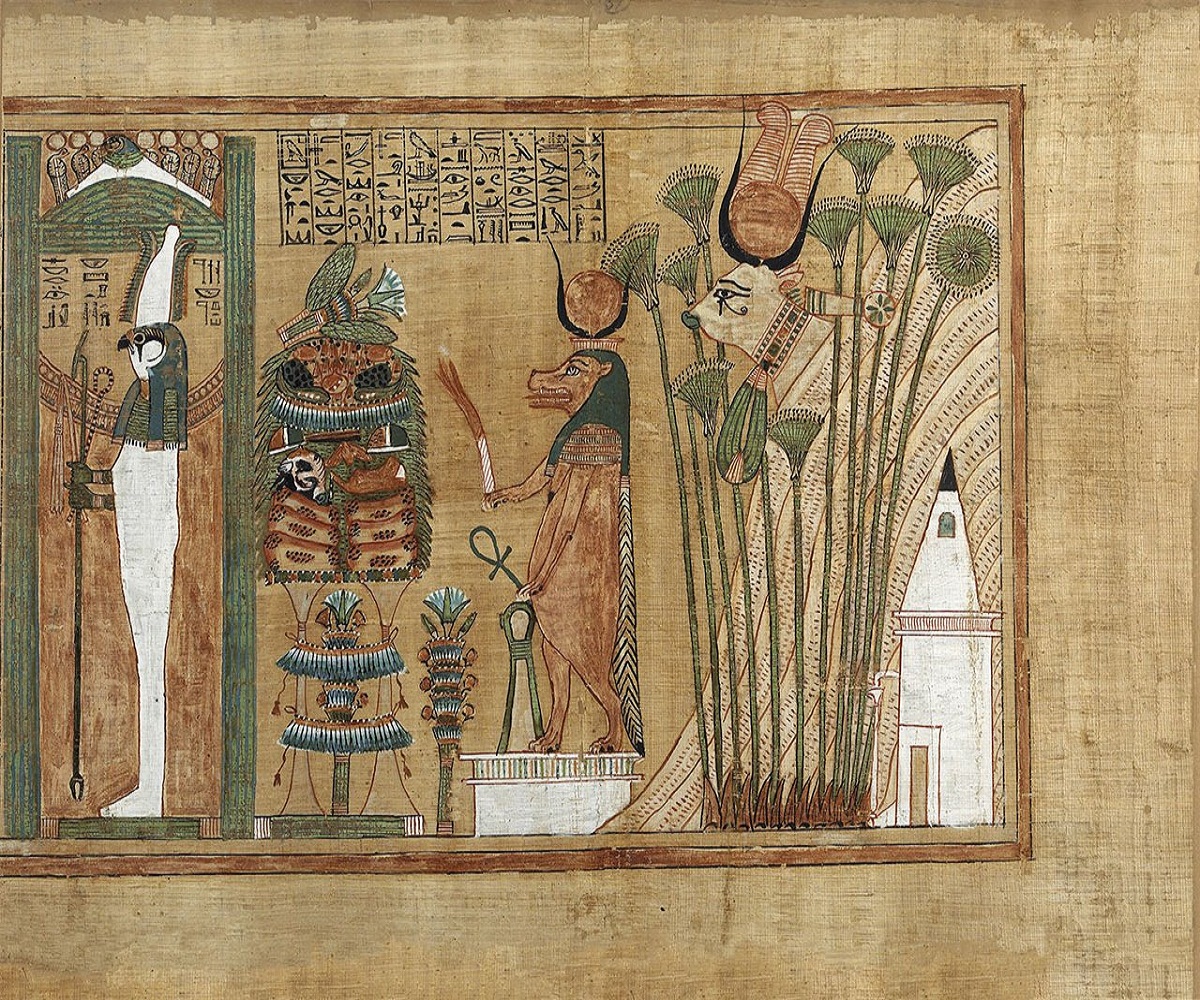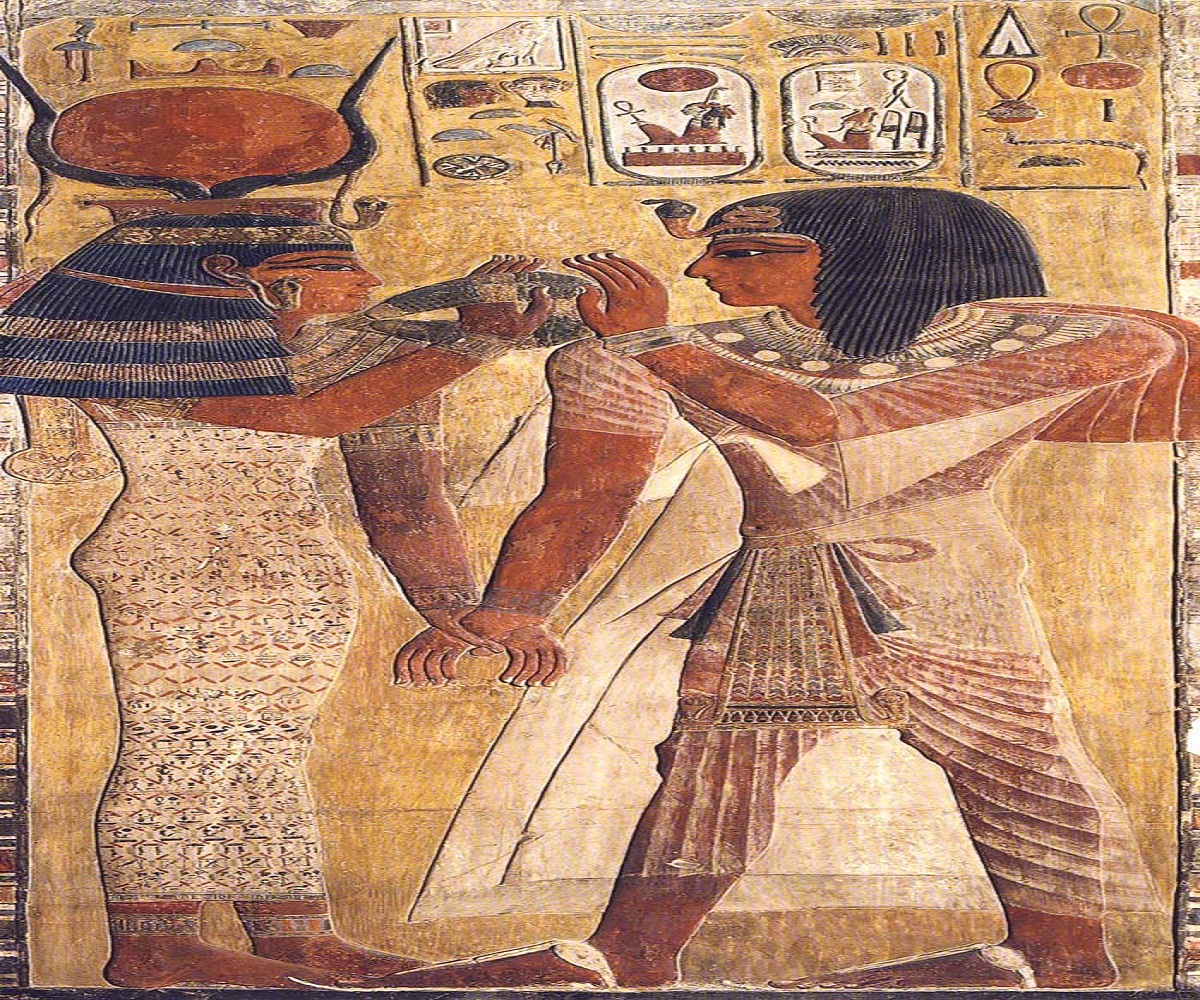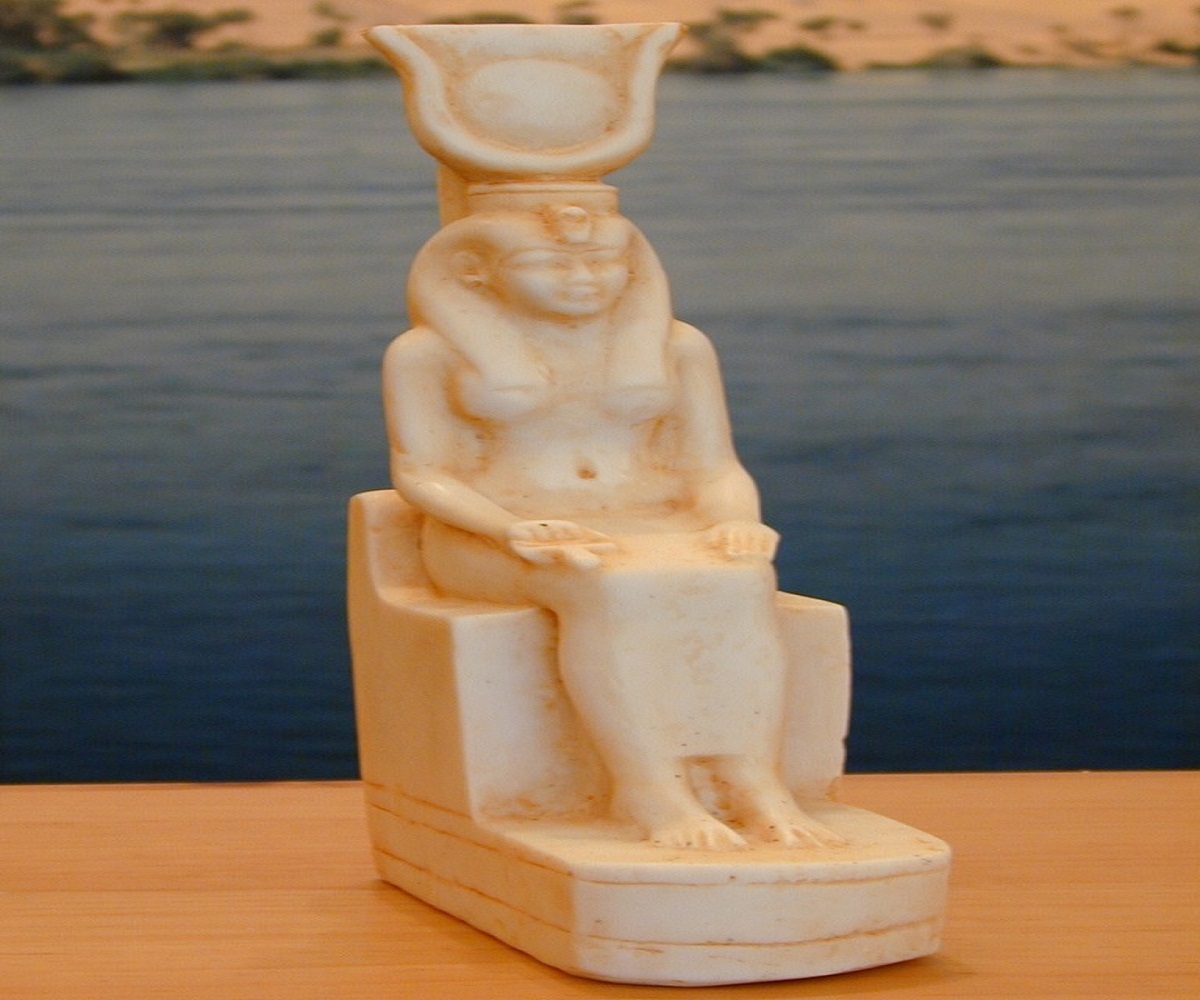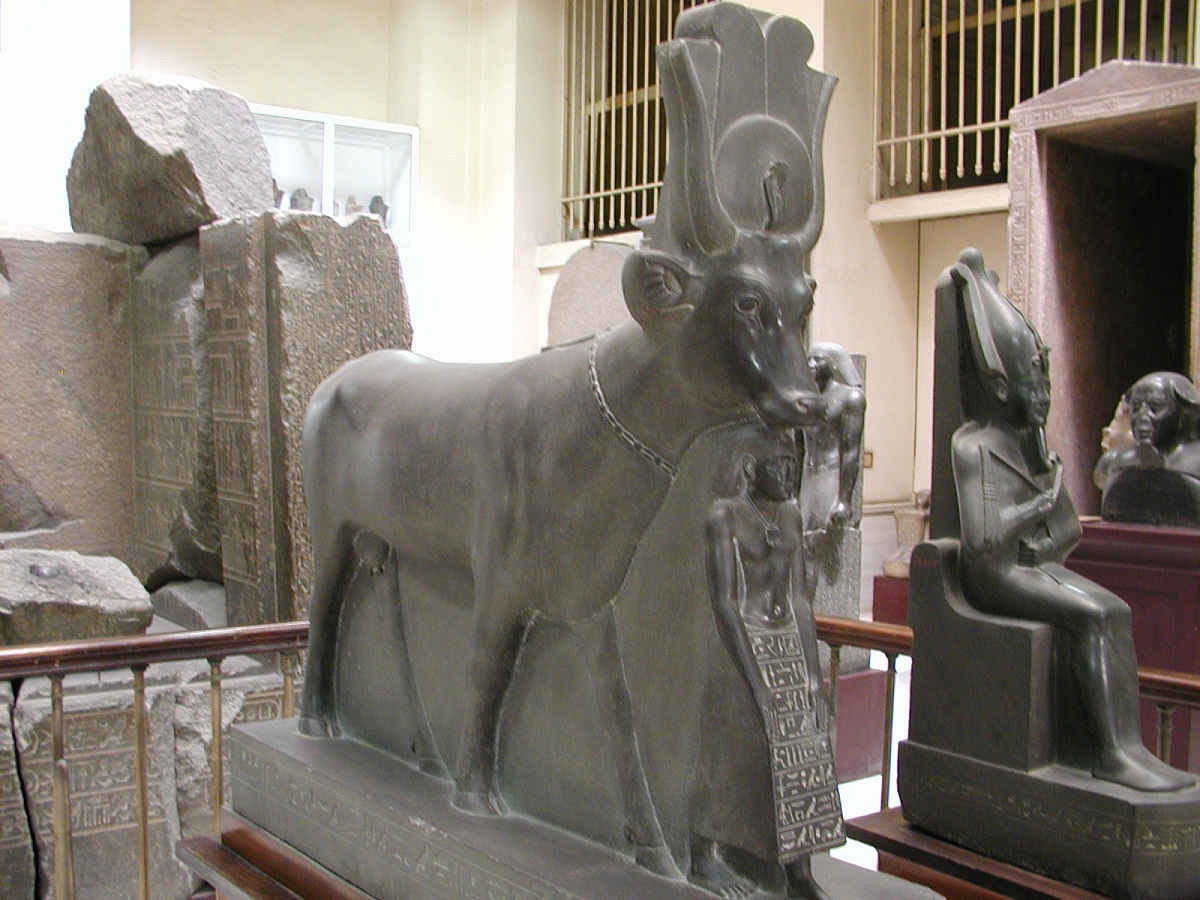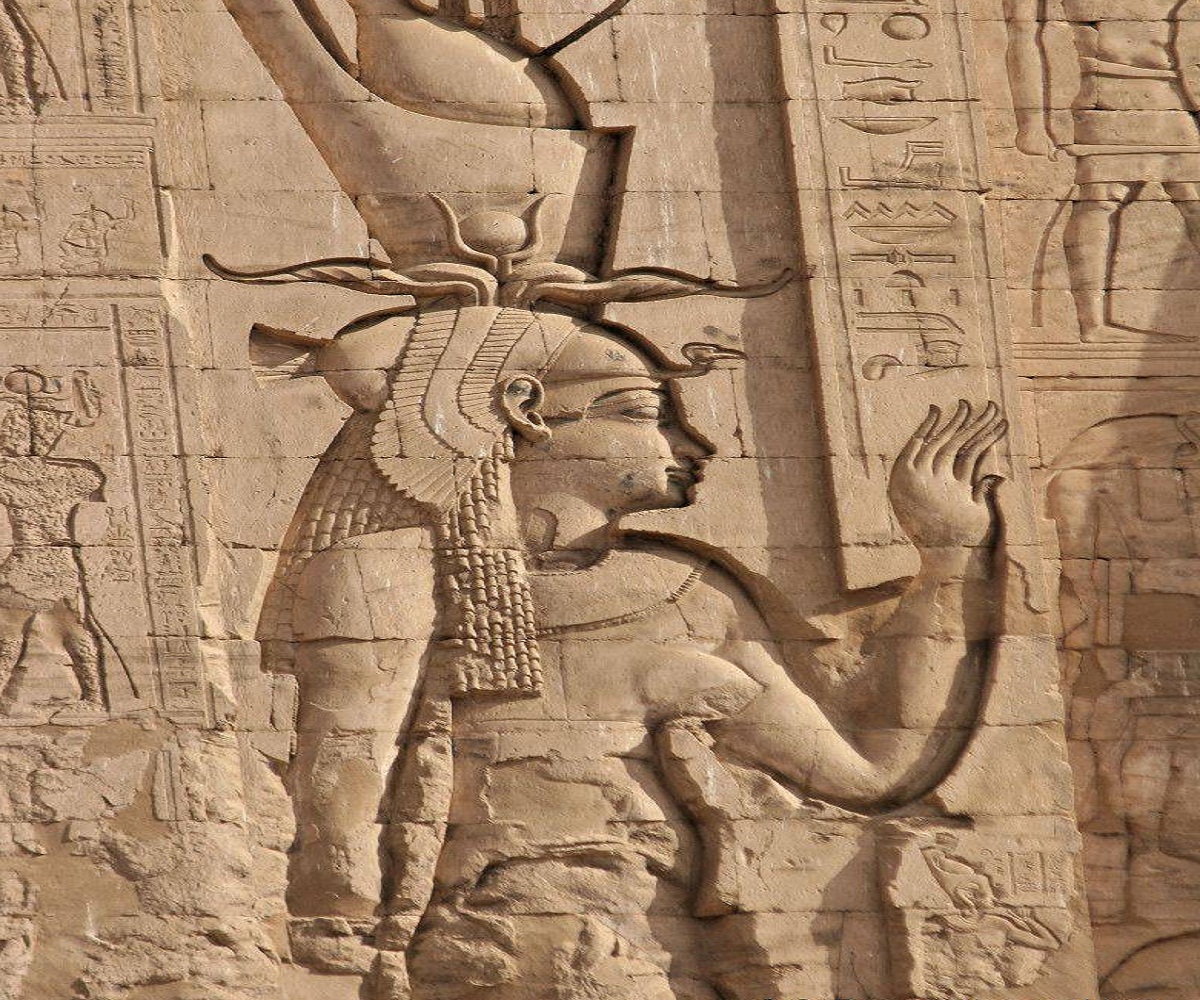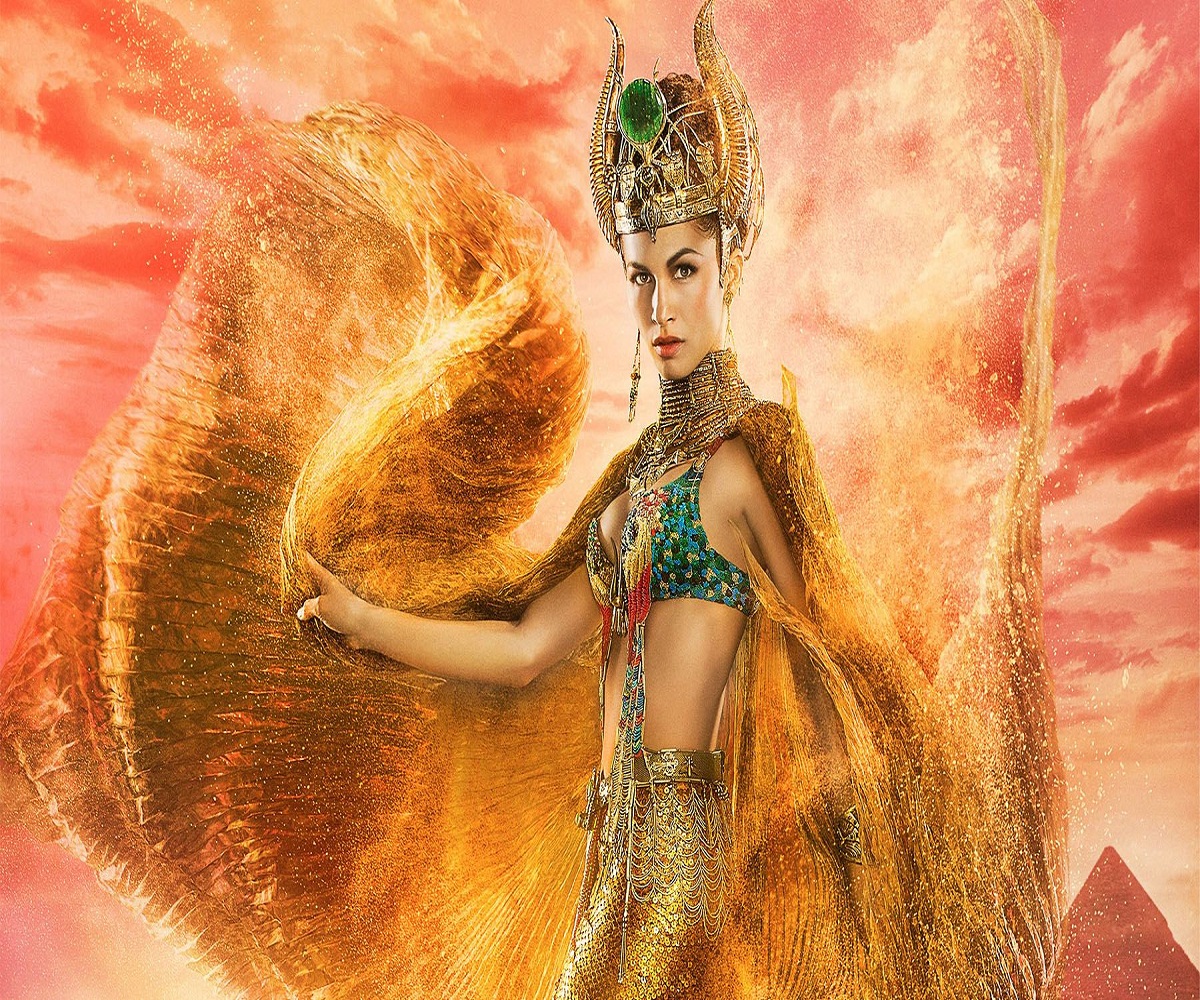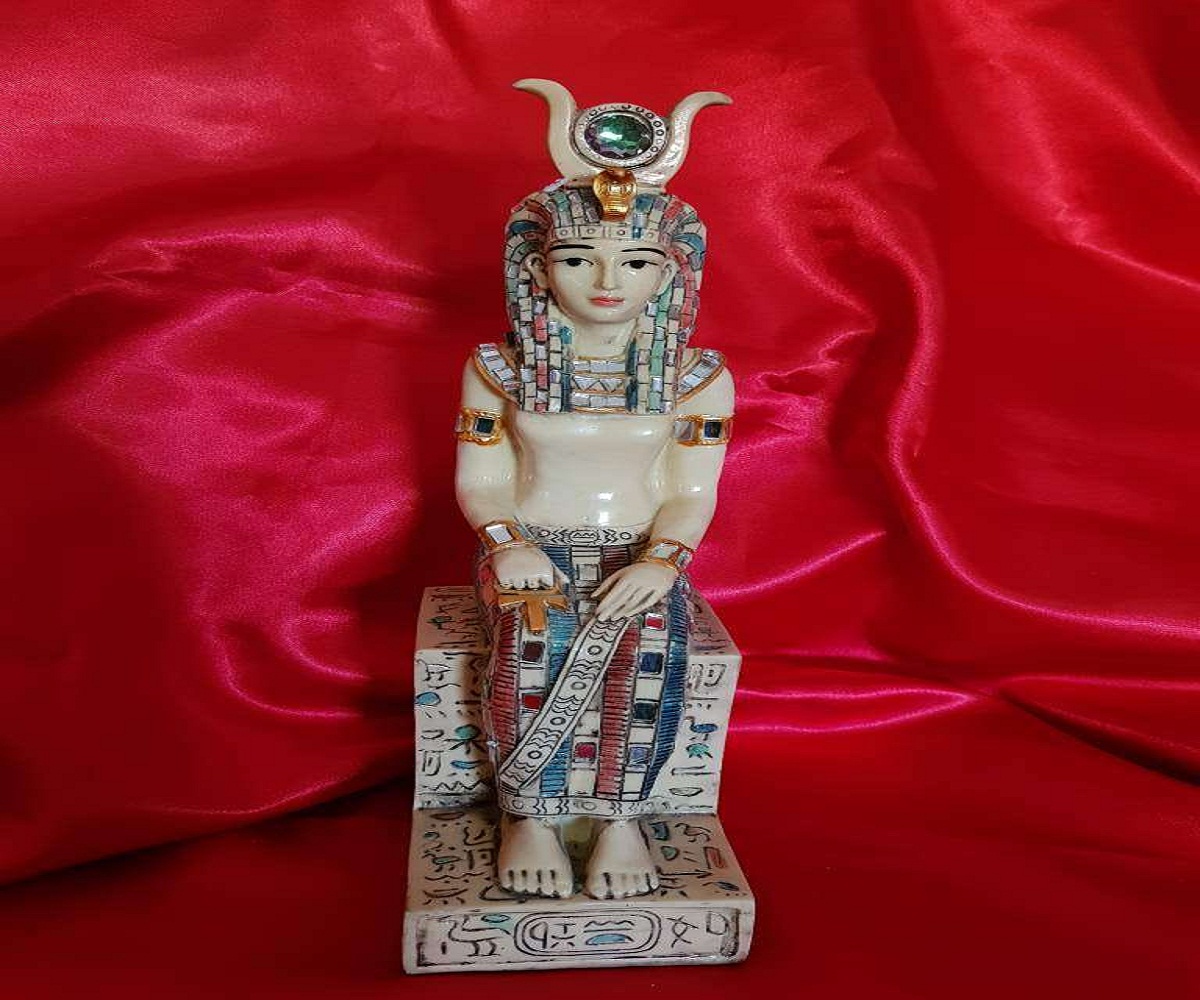I invite you to know all the details of the Goddess Hathor known as the daughter of the Sun God. One of the most important divinities of the Egyptian religion during the Middle and New Kingdom. She also was the mother, the wife, the consort, the sister and the eye of Ra and the God Horus. She is also known as the goddess of joy, motherhood and the protector of children. Keep reading and learn more about the goddess!
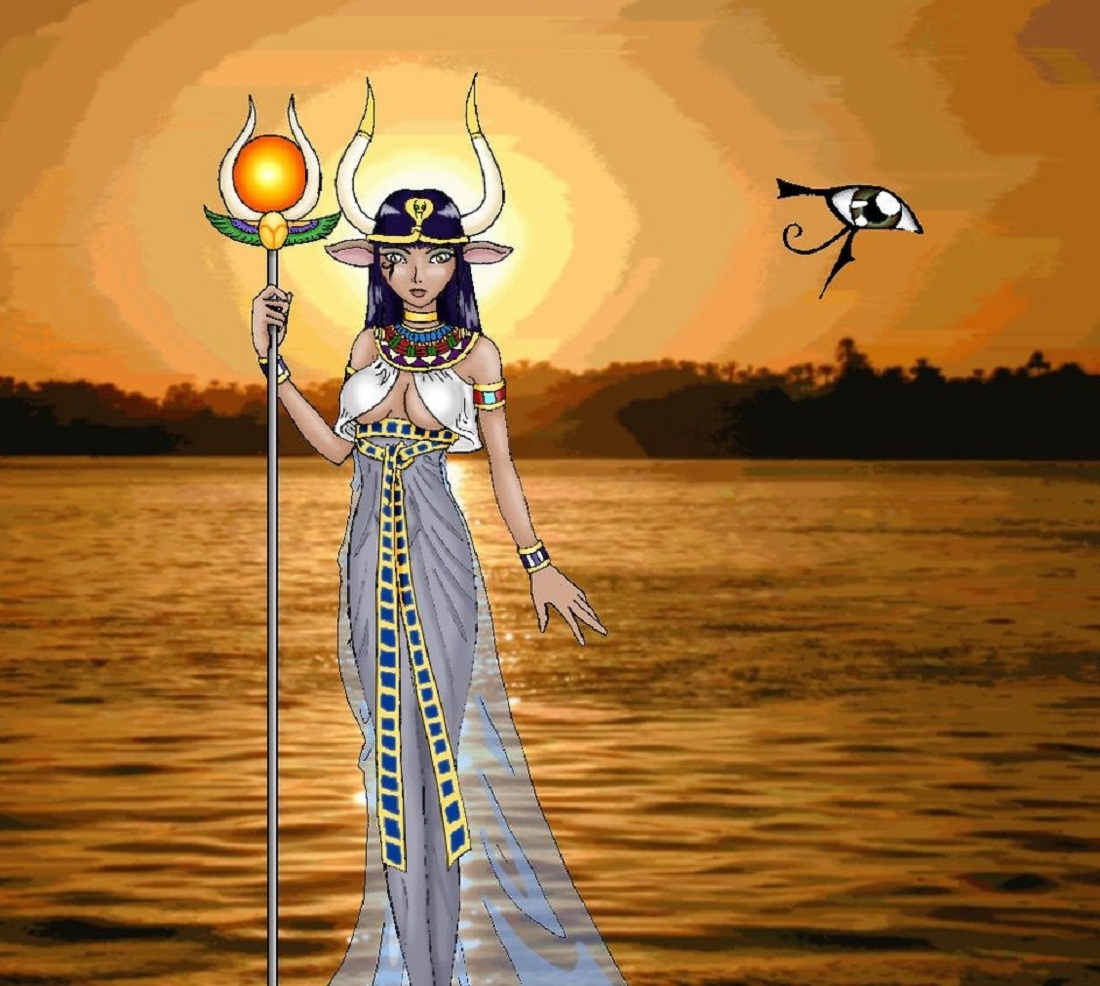
Goddess Hathor
The Goddess Hathor is one of the main goddesses and referents of the religion of Ancient Egypt. She that she was engaged in performing different jobs and routines for the Egyptian people. The Goddess Hathor is a sky deity. She that she was known as the Mother and as the consort of the God Horus and in the same way with the Solar God Ra.
This deity has always been associated with the royalty of Ancient Egypt. For what the Goddess Hathor has been known as the symbolic mother of the Egyptian pharaohs, since she was the one who represented them in the earthly sphere. In addition, the Goddess Hathor had a very important role when she assumed the responsibility of being the Eye of Ra as a female figure.
Bearing the figure of the Eye of Ra. She possessed a vengeful way and in this way she defended herself from her enemies. But she also has a charitable side that is represented in joy, love, dance, music, sexuality and maternal care. But the Goddess Hathor was to act as the consort of many Egyptian male deities and as the mother of her children.
These aspects that the Egyptian Goddess Hathor demonstrated make a great example of the Egyptian conception of femininity. It is said that the Goddess Hathor was able to cross borders in aid of deceased souls who were lost in the transition from life to death.
The Goddess Hathor has also been represented in Egyptian mythology with the figure of a cow, since this animal is associated with the maternal and the celestial. But the most representative form of her is that of a woman with a pair of cow horns and in the center of her she carries a solar disk. Equal to the Goddess Hathor she has also been represented with the figure of the lioness, the sycamore or ureo.
Currently there are representations of the Goddess Hathor in bovine figures that are similar to Egyptian art that were made in the fourth millennium BC. But the investigations that have been carried out say that the Goddess Hathor possibly made its appearance in the Old Kingdom Egyptian dating between the years 2686 AD and 2181 BC. c.
This could be done with the help of the Egyptian rulers and pharaohs of the time who led the Old Kingdom in this way the Goddess Hathor became one of the most important deities in Egypt. She being one of the Goddesses that more temples were dedicated to her, of which the most outstanding was that of Dendera located in Upper Egypt.
Likewise, the Goddess Hathor was worshiped in the Temples of the male deities who were her consorts. The Egyptians had great adoration for it that linked it with foreign lands such as Canaan and Nubia since these lands possessed valuable goods such as semi-precious gems and incense. In the same way, many peoples of these lands worshiped him.
But in Egypt the Goddess Hathor was one of the most invoked deities in the private prayers of the Egyptian people and various votive offerings were made to her. The ones who gave him the most offerings were the women because they wanted to get pregnant and have children.
In the New Kingdom dating between 1550 BC and 1072 AD, the Egyptian Goddesses Isis and Mut occupied the position held by the Goddess Hathor both in royalty and in the ideology that she occupied in the Egyptian Empire. But she was still one of the most admired and loved Goddesses by the Egyptians.
After the Egyptian New Kingdom came to an end, the Goddess Hathor was further overshadowed by the Goddesses Isis who took on a lot of prominence. But she had many faithful and a great cult was paid to her until the ancient religion was extinguished in the first centuries of the present era in which we are living.
Origins of the Goddess Hathor
The origins of the Goddess Hathor are closely related to the images of cows, since they appear very frequently in the works of art that were painted in Ancient Egypt dating from the year 3100 BC. In the same way they have highlighted the figures of women with their arms up and in the shape of a curve that make the representation of the horns of the cows.
All the images that are made in Egyptian art that are made in representation of cattle and women with their arms raised have some relationship with the goddess Hathor. Since the cows in the Egyptian culture have been highly revered because they represent symbols of food and motherhood. Since the cows take care of their children and supply them with the necessary milk so that they can be raised and strengthened. In the same way, humans feed on the milk produced by this animal.
There is a piece of Egyptian art called The Gerzeh Palette, which is considered to be a stone that belongs to the prehistoric period of Nagada II between 3500 BC and 3200 AD. This Egyptian work of art features the figure of a cow's head with inward-curving horns surrounded by various stars.
The way Gerzeh's palette is made suggests that the cow is very close to the sky. In the same way in the Egyptian culture they represented several goddesses in later times united to the sky and in the shape of a cow, among them the goddesses Hathor, Meheret and Nut stand out.
However through all these precedents the Goddess Hathor is not mentioned anywhere, but when the fourth Egyptian dynasty arrives between the years 2613 BC and 2494 AD. in the Ancient Egyptian Kingdom. But there are many objects that are linked to the Goddess Hathor that belong to the time of the Archaic Period that dates between the years 3100 BC and the year 2686 AD.
But when the Goddess Hathor has her clear form, the horns she wears on her head curve outward, rather than inward like those found in predynastic Egyptian art. That is why an Egyptian deity with horns curved inwards is found on the Narmer Palette. And this palette dates back to the beginnings of Egyptian culture. As is the top of the palette like King Narmer's belt.
But according to the studies that have been carried out on the Narmer Palette, the Egyptologist Henry George Fischer came to affirm according to his investigations that the goddess that appears in the Narmer Palette is the goddess Bat. One of the Egyptian goddesses who over time was represented with the face of a woman but she had antennae that bent inward and were reflected inward like the horns of the cow.
But other investigations that were carried out by the Egyptologist Lana Troy came to the conclusion that in the passages of the texts of the Pyramids of the Ancient Egyptian Kingdom the Goddess Hathor is related to the king's apron that makes a union with the belt of the king. King Narmer and this suggests that she is the Goddess Hathor and not the Egyptian goddess Bat.
In the fourth Egyptian dynasty the Goddess Hathor became a very famous and prominent deity thus displacing a very primitive Egyptian Crocodile God who was worshiped at Dendera. This was located in Upper Egypt. In this way the Goddess Hathor became the patron saint of that city.
While in the Hu region, a great cult was being paid to the Egyptian goddess Bat. But from the years 2055 BC and 1650 AD these deities were united giving a single name known as the Goddess Hathor. On the theology that exists around the Egyptian pharaohs of the Old Empire, it was centered on the God Ra, being this the king of all the Egyptian gods and the patron of the pharaoh or earthly king. While the Goddess Hathor ascended to heaven with the God, she became his wife and therefore is the mother of all pharaohs.
Functions that the Goddess had in the Egyptian Culture
In Egyptian culture the Goddess Hathor had various forms and performed many functions for the Egyptian people. In investigations carried out by the Egyptologist Robyn A. Gillam, where he came to affirm that this diversity of forms that the Goddess Hathor adopted occurred because the court of the Old Kingdom decided to replace several deities that the Egyptian people worshiped. Assuming that this was given by manifestations of the Goddess Hathor to the royalty of the Old Kingdom.
In the ancient texts of Egypt, there is information about the manifestations of the Goddess Hathor, where it is reported that they existed “Seven Hathors” but there are other texts where there is information about more goddesses up to the amount of 362. For this reason the Egyptologist Robyn A. Gillam has come to assert "That the Goddess Hathor has been a type of deity and that she does not possess a single entity." That is why this variety has been reflected in a great variety of attributes that the Egyptian people associated with the Goddess Hathor, which are the following:
Celestial Goddess: To the Goddess Hathor, several qualifiers were placed from the Lady of the sky to the Celestial Goddess. Since the Egyptian people said that she lived in the sky with the Egyptian God Ra and with other solar gods. For the time, according to research, the Egyptian people believed that the sky was like a body of water and the Sun God navigated it.
That is why it is told in their myths about the creation of the world that the sun emerged at the beginning of time. While the Goddess Hathor was represented as a cow being the cosmic mother of the Egyptians. She, then, was considered the Goddess Hathor and the goddess Meheret as the cow that gave birth to the Sun God and placed him between his horns to protect him.
In the same way, it was said that the Goddess Hathor gave birth to the Sun God at each sunrise. Since he is born every day. That is why her name in Egyptian was ḥwt-ḥrw or ḥwt-ḥr, which can be translated as "House of Horus" Similarly, it can be understood as “my house is heaven” That is why the falcon god Horus represented the sky and the sun for the Egyptian people.
In this way, when speaking of the house of the God Horus, reference is made to the womb of the Goddess Hathor or to the sky where she moved or as the Sun God that is born at each sunrise.
Sun Goddess: Similarly, the Goddess Hathor was known as one of the solar goddesses, and was the female counterpart of the solar gods Ra and Horus. She was part of the divine retinue that kept God Ra company, while he was sailing through the skies in his great ship.
That is why the Goddess Hathor was known as "The Golden Lady” because its radiance was very similar to that of the sun and in ancient texts that the city of Dendera is said to “The rays of light that emerge from it illuminate the entire Earth”. With the stories that were told, she was coupled with the goddess Nebethetepet and her name meant Lady of the offerings, Lady of joy or Lady of the vulva.
In the city of Heliopolis, the God Ra, the Goddess Hathor and Nebethetepet were worshiped because they were the consorts of the God Ra. In this way, the Egyptologist Rudolf Anthes came to consider that the name of the Goddess Hathor refers to one of the houses of Horus in the city of Heliopolis and that it was closely linked to the thoughts of Egyptian royalty.
The Goddess Hathor was also one of the goddesses who fulfilled the role of the Eye of Ra. She represented the feminine part within the disk of the Sun and a part of the power that the God Ra had. It is also interpreted as the Eye Goddess who was considered as a womb where the Sun God was born. In this part the functions of the Hathor Goddess were contradictory as she was mother, lover, wife, sister and daughter of the God Ra being here the reflection of the sun's daily cycle.
In the afternoons, the Sun God returned to the body of the Goddess, impregnating her again and engendering the deities that would be born the next morning. As the same God Ra who was reborn, as well as his daughter the Eye Goddess. That is why the God Ra gives rise to his daughter and at the same time gives rise to himself and this generates a constant regeneration.
The Eye of Ra is intended to protect the Sun God from enemies and was most often depicted as an upright cobra, auran, or lioness. Another form that the Eye of Ra is known is the form that is known as "Hathor of the four faces” and is represented by four cobras where each face is pointing to a cardinal point in this way it can monitor the threats that may lie in wait for the Sun God.
That is why there are several myths in the New Kingdom dating between 1550 BC and 1070 AD where it is told when the Eye Goddess begins to get angry without having control of herself. An important myth is described in the sacred funerary book entitled “The Book of the Sacred Cow”.
Where the God Ra sends the Goddess Hathor as the Eye of the God Ra in order to inflict punishments on humans who think of planning a rebellion against the government of the Pharaoh that the God Ra has placed. The Goddess Hathor turns into a great lioness and begins to slaughter all the people who planned such an attack against the pharaohs.
But the God Ra has the decision of the Goddess Hathor turned into a lioness to kill all humanity and orders that the beer be dyed red and distributed throughout the Earth. The Eye Goddess begins to drink the beer and mixes it with the blood and being drunk the goddess returns to her beautiful and merciful state.
Closely related to this story is the myth that is narrated of the Distant Goddess, in the late and Ptolemaic periods. Where the Eye Goddess in the form of the Goddess Hathor begins to rebel against the control that the God Ra possesses and she begins to carry out many destructions in some foreign country, which can be Libya to the west, Nubia to the south, so when She is weakened by the loss of the Eye of Ra and that is when the God Ra sends another God named Thoth to take her back.
The Egyptian Goddess Hathor being calm and peaceful, she again becomes the consort of the Sun God or the God who brings her back. That is why the aspects that the Eye Goddess possesses, which are beautiful and cheerful and the violent and very dangerous one, will reflect the Egyptian belief that women "embrace the extreme passions of love and fury"
Joy, Dance and good music: In Egyptian culture, one of its main purposes is to celebrate the pleasures that give meaning to life and that are considered as the gifts that the gods give to humanity. That is why the Egyptians dedicated themselves to dancing, eating, drinking and playing at religious festivals. The air was perfumed with flowers that smell of incense.
Many of the forms that the Goddess Hathor adopts were associated with celebrations and she is also known as the mistress of music, parties, dance, garlands, drunkenness and myrrh. When the Hymns are played in the Temples, the musicians must play the harps, lyres, tambourines and sistrums in honor of the Goddess Hathor.
The sistrum is an instrument that looks like a rattle and was widely used in the worship of the Goddess Hathor, as this instrument had erotic and sexual connotations. That is why this instrument was related to the creation of new life.
These aspects mentioned above also relate to the myths told of the Eye of Ra. Since it was pacified with the myth of beer and the destruction of all mankind was prevented. In the versions that exist about the Distant Goddess, due to its wild nature, the Wandering Eye diminished when it was appeased thanks to the fact that civilization promoted dance, music and tasty wine.
The water of the Nile River when it grows turns red due to the sediments of the stones, this was compared to the color of wine and beer that was colored red due to the myth of the destruction of humanity. In this way, the festivities in the name of the Egyptian Goddess Hathor were held during the flooding of the Nile River and at that moment they began to play music and dance while drinking many drinks, thus appeasing the fury of the returning goddess.
In the ancient text of the temple of Edfu it is said that the Egyptian Goddess Hathor the following: "The gods play the sistrum for her, the goddesses dance for her to get rid of her bad temper”. In the Temple of Madamud a Rattaui hymn is sung to him in which the festival is described as that of drunkenness.
It is performed as the mythical return of the Egyptian Goddess Hathor to Egypt, at which time women can bring her flowers, while drunks and players play drums for her. Other people dedicate dances to him in the box of the temples since the noise and the celebration will ward off negative environments and hostile powers.
In this way it can be ensured that the Egyptian Goddess Hathor is in her most joyous form while her male consort awaits her in her temple, although the mythological consort of the goddess Hathor is the God Montu who will bear her a son.
Beauty, Love and Sexuality: the cheerful side of the Egyptian Goddess Hathor indicates that she has great feminine and procreative power. That is why in several myths of the creation of the world she helped create the Earth. Since it was said that Atm was a creator God and that he contained within himself all things. Everything had been generated through a masturbation between Shu and Tefnuf and in this way the process of creation begins.
The hand that was used to perform this act was the hand of the God Atum, who was the one that represented the feminine side and was also represented as the goddess Hathor, Nebethetepet or Iusaaset. Although it is only a very old myth in the Egyptian culture that dates back to the Ptolemaic period between 332 BC and 30 BC, the God Jonsu is the one that will play a very fundamental role in this Egyptian period since both gods are paired thus giving the possible creation of the world.
In this way it is assumed that the Goddess Hathor would be the consort of many male Egyptian Gods, but the most important God for the Egyptian Goddesses Hathor was the Sun God Ra. While the goddess Mut was the usual consort for the God Amun who was the main deity of the Egyptian New Kingdom. Although the Goddess Hathor has always been related to the God Ra.
While the gods Amun and Nut are rarely related to fertility and sex, and in several situations they place deities such as Isis or the Goddess Hathor. That is why in the last moments of Egyptian history the God Hathor and the Sun God Horus were considered as a couple in the cities of Dendera and Edfu.
In other versions that are told, it has been affirmed that the Distant Goddess together with the Goddess Hathor and Rattaui were the consorts of the God Montu. That is why in the sexual aspect there are many stories. For example, there is a story that occurred in the Middle Egyptian Empire that had the name The story of the Shepherd. Where he meets a hairy goddess who looks like an animal. And when he watches her in the swamp, he is very scared. But another day when passing through the swamp he finds himself with a much more beautiful and seductive woman.
Egyptologists who have studied this story have come to the opinion that the woman referred to is the Goddess Hathor or a woman with very similar characteristics since she is very wild and dangerous but at the same time very sensual and good. Another researcher named Thomas Schneider came to say that the encounters the shepherd had with the Goddess were to appease her.
In another short story that belongs to the Egyptian New Kingdom where there is a dispute between Seth and Horus, it is a conflict between these Egyptian gods. Since the Sun God is upset since the other God insulted him. While he lies down on the ground to rest. After a while, the Goddess Hathor shows the intimate part of her to the Sun God so that he will get over the rage that she has.
After that, the Sun God got up from his seat and began to carry out his duties as the ruler that he is. At that moment in the story, the entire population believed that order and life depended on the mood of the Sun God. Therefore, the actions of the Goddess Hathor were essential to prevent the destruction of humanity.
This act is not clear if it was an act to have sexual relations or for the God to take away the anger he was feeling, so it is not very clear why the God Ra began to smile at the Goddess Hathor. In other Egyptian literatures the Egyptian Goddess Hathor was praised for the beautiful hair she has of hers and hints are also made that the Egyptian Goddess Hathor while she was enacting her sexual allure lost a lock of her hair.
This lock of hair that the Egyptian goddess Hathor lost has been compared to the divine eye that the god Horus lost and when Seth lost his testicles during the harsh shower between these gods, implying that the lock that the goddess Hathor lost was as important as the mutilation that both gods had in their bodies.
Although the Egyptian Goddess was known as the lady of love. Because of the sexual aspect that she had of her because in the extant papyri of Chester Beatty I, from the 1189th dynasty (c. 1077-XNUMX BC), men and women dedicate poems to the goddess Hathor so that she will take them to the lovers of it. Where there are affirmations that even comment that they prayed to the goddess and her lover arrived at her chambers.
Royal dignity and motherhood: the goddess Hathor has been considered the mother of many Egyptian deities. She is also considered the mother of the God Horus but at the same time fulfills the function of being the consort of the God. She is also the wife of the King and the mother of the Heir. The goddess Hathor is the divine counterpart of the queens on Earth.
In Egyptian Mythology it is considered that the parents of the God Horus are Osiris and Isis. In the Myth of Osiris that is narrated from the Ancient Egyptian Empire, the God Horus maintains a relationship with the Goddess Hathor, although it is affirmed that this myth is older. Since the God Horus is only related to the Gods Osiris and Isis when the myth of Osiris appears.
Although over time the Goddess Osiris was consolidated as the mother of the God Horus, the Goddess Hathor always had that role, especially when she had to breastfeed a new pharaoh. That is why there are papyri where a cow is represented that is breastfeeding a child in the bushes, that is represented as the education that the child had in Egyptian mythology.
The milk that the Goddess Hathor gave the child was a sign of royalty and divinity and when it had images of the Goddess taking care of the child, it is because that child had every right to govern that people. In this same way, the relationship that exists between the gods Horus and Hathor gave their personality a healing power. Because the lost eye of Horus was said to have been restored after the god Seth had mutilated it.
In the late period dating between 624 BC and 323 BC, the Egyptian population focused on worshiping only one divine family and a single adult male deity, who had a wife and a young son. In this way, auxiliary buildings known as mammisis began to be built, in order to be able to celebrate the birth of the child deity.
Since this child God is going to present a cyclical renewal of the cosmos and is going to be a new heir to royalty, being the Goddess Hathor mother of many local figures of Gods that form a triad. In the city of Dendera and Edfu the God Horus was the father while the Goddess Hathor was the mother while her son was known as Ihy and his name meant the musician of the sistrum.
This son of Horus with the goddess Hathor personified the joy that was associated with the sistrum instrument. They also had other children such as a minor deity known as Neferhotep in the so-called city of Hu. In the same way, several children's representations of the God Horus were made.
In the Egyptian people, the milky sap of the sycamore was taken as a sign of life and health. In this way it became a very important symbol for the Egyptians. Since this milk was equated with the waters of the Nile River at the time of the floods since it brought fertility to the Earth that was dry and barren.
At the end of the Roman periods and the Ptolemaic period in several Egyptian temples the myth of the creation of the world was included, where ancestral ideas about the creation of the universe were adapted. The version that exists of the myth of the Goddess Hathor in the city of Dendera places great emphasis on her being a female solar deity.
In addition to being the first Egyptian Goddess to emerge from the primordial waters that were born after creation and according to sacred manuscripts that the light and milk of the God Hathor were able to nourish and fill all human beings with life.
Like the Goddess Mesjenet, who is related to motherhood. But the Goddess Hathor has the concept of destiny that is based on the fact that the goddess will adopt seven different forms in order to know who will be the pharaohs who will be born and to be able to predict those who will die. As told in the story of the two brothers and in the story of the fated prince.
The maternal facets that the Goddess Hathor adopts can be compared with the facets that the goddess Isis and the goddess Mut have. But in both there are very different nuances since the devotion that the Goddesses Isis presents for her husband and son will represent a love that is accepted by society, than the more sexual and uninhibited love that the Egyptian goddess Hathor offers to the couples of her
While the love offered by the Goddess Mut is of a more authoritarian than sexual nature, while the Goddess Hathor has the characteristics of seducing married men as if she were a strange woman for them.
In foreign Lands and in trade: Being Egypt an Empire at that time, it maintained many commercial relations with several countries and with coastal cities such as Syria and Canaan. Especially with the city of Byblos. This made the Egyptian religion spread to other cities in that region.
All this was achieved during some time of the Ancient Egyptian Empire. This is why the Egyptians were making references to the Goddess and patron saint of the city of Byblos who was known as Baalat Gebal. This Goddess was said to be a local goddess compared to the Goddess Hathor. These links in both goddesses became so strong that ancient texts from the city of Dendera say that the goddess Baalat Gebal also inhabited that city.
Similarly, the Egyptians compared the Goddess Hathor with the Goddess Anat, a goddess known for her fertility. This goddess of the city of Canaan was very sensual but at the same time very aggressive that she was worshiped by the Egyptians in the New Kingdom.
In the Egyptian works of art from the city of Canaan, the naked goddess Anat is present wearing a curly wig that may come from the figures that were made of the goddess Hathor. Although according to studies it has not been determined that the goddess represents the images and why the Egyptians adopted this iconography in relation to the goddess Anat. Although she was worshiped as a female deity separate from the Egyptian goddess Hathor.
The solar character of this goddess has played a very important role in the link with trade since the Egyptians believed that she would protect the ships that sailed on the Nile River and in the seas that were beyond Egypt. Because her mission was to protect the boat used by the God Ra in the sky.
Similarly, the pilgrimage made by the Nubian Goddess in Egyptian mythology was also linked with the goddess Anat in these lands. She was also closely linked with the Sinai Peninsula. That at that time was not considered part of the Egyptian Empire. But it was a set of Egyptian mines where various minerals were exploited, among them were copper, turquoise and malachite.
One of the epithets with which the goddess Hathor was called, at that time it was the turquoise lady. This refers to minerals that had a bluish-green color. That is why the Egyptian goddess Hathor was also known as the Lady of Faience. This was a blue and green colored pottery which the Egyptians said was the color turquoise green.
The Egyptian goddess Hathor was highly worshiped in the mines to protect the lives of slaves and in various quarries and mining sites that were found in the Arabian desert of the Egyptian Empire. In the amethyst mines of Wadi el-Hudi, where she was sometimes called Lady of the Amethyst.
In the southern region of Egypt, the influence of the Goddess Hathor extended to the ancient territory of Punt. It was located along the coastal area that borders the Red Sea and this was the main source of incense with which the goddess Hathor was linked. In the same way, she took over the region of Nubia that was northwest of the Punt territory.
In the biography of the official Herjuf who belonged to the VI dynasty between the years (c. 2345-2181 BC), he left written an expedition that was made to a territory near the city of Nubia. There were brought large quantities of ebony and various skins from the panthers and incense for the Pharaoh. In that text that the high Egyptian official left written, he describes how these goods that they brought from that territory were very exotic and were a gift from the Goddess Hathor to the Pharaoh.
In the other expeditions that were made to the territory of Nubia with the mission of extracting gold, they introduced a new cult during the new and middle Egyptian empires. For which several pharaohs decided to build several temples in the Nubian region where they were the rulers.
Life after death: There are stories that claim that various goddesses helped deceased souls to find their purpose in the afterlife. One of this goddess was known as Amentit. She was a goddess of the west who represented a cemetery known as a necropolis or a group of tombs that were on the banks of the Nile River, she was known as a kingdom of life after death.
The Egyptians considered this to be the work of the Goddess Hathor. In this same way as the Goddess Hathor came to cross the border of the Egyptian Empire and other lands, she was able to cross the border between the realms of the living and the realms of the dead. She helped the souls of the deceased to be able to enter the kingdom of the dead, that is why she was closely linked to the tombs, it was there that the transition to these kingdoms began.
In the Theban necropolis it was represented as a stylized mountain where a cow appeared in representation of the Hathor. The role that she fulfilled as a goddess in heaven was closely related to life after the person had crossed over to the realm of the dead.
As Goddess of the sky she had to assist the God Ra in his daily rebirth. That is why she had important roles in the beliefs that the Egyptian people had since she helped the deceased souls in the realm of the dead since many had the belief that they will be reborn as a new sun at each dawn.
The tombs and the underworld were interpreted as the womb of the Goddess Hathor from which the deceased will be reborn. In this way the goddesses Nut, Hathor and Amentit could, in different ancient texts, take the souls of the deceased to a place where they could eat and drink for all eternity. That is why the goddess Hathor together with the goddess Amentit are represented in the tombs.
Thus they welcome newly deceased souls into the realm of the dead as they do their children before they are reborn again. In the funerary texts that are known from the New Kingdom, life after death was illustrated as a very beautiful and fertile garden for planting. Who presides over this beautiful garden was the goddess Hathor.
The goddess here was represented in the form of a tree and gave water to the soul that was recently deceased. While the goddess Nut had another assignment but the Goddess Hathor called her to fill in for her work. It is important that in the Egyptian culture life after death had a sexual component.
Because in the Myth of Osiris when the God is killed, he resurrected when he finds himself copulating with the goddess Isis and Horus is born there. In the same way, in the solar ideology that there is the union between the God Ra and the Goddess of the sky, they are going to allow the God Horus his own rebirth. In this way, the sexual act will allow the deceased to be reborn again.
That is why the Goddesses Isis and Hathor contribute to the awakening of the deceased to a new life, this is done by stimulating the regenerative powers of the male gods instead of fulfilling or playing a fundamental role. The ancient Egyptians preceded the deceased and placed the name of Osiris in order to connect it with the resurrection.
A clear example of this was the woman known by the name of Henutmehyt would be "Osiris-Henutmehyt" Over time this woman was related to the divine feminine and masculine powers. While in the Ancient Egyptian Kingdom it was taken for granted that women were to join the worshipers of the Goddess Hathor in the afterlife. Men must have done the same with Osiris.
In the third intermediate period of the Egyptian empire dating between the years (c. 1070-664 BC), the Egyptian people began to add the name of the Egyptian Goddess Hathor to women who died instead of placing the name of Osiris.
But in other cases, many deceased were given the name of Osiris-Hathor to indicate that the deceased had the benefit and revivifying power of both deities. During that period of the Egyptian Empire it was held as a valid belief that the Goddess Hathor ruled in life while Osiris ruled in death.
Iconography of the Hathor
As previously mentioned, the Goddess Hathor is represented with the figure of the cow that carries a solar disk on its curved horns. This figure was very special when the goddess was nursing the pharaoh. In this same way the Goddess Hathor could appear as a woman who has the head of a cow. But the most usual representation that was made of the Goddess Hathor is of a woman wearing cow horns and a sun disk.
This representation she wore a red or turquoise tube dress or a combination of both colors and the horns were placed in a low half or the headdress of a vulture that was very typical in Egyptian human queens in the New Empire Egyptian.
When the Goddess Isis adopted that same headdress in the New Kingdom the two goddesses could only be distinguished when the image had a written label with the name of the goddess. The role of the goddess Amentit. The goddess Hathor wore on her head wearing the emblem of the west instead of wearing the cow's horns.
The Seven Hathors made the representation of a set of seven cows together that were accompanied by a minor god of heaven and life that after death was known as the bull of the West.
It was also represented by other animals such as the ureo that was in the form of a cobra. Which is a motif of Egyptian natural art and represents various goddesses that could be identified with the Eye of Ra.
When she was shown with the ureo they represented her most violent side but at the same time the most protective. In the same way, she was made to appear transformed into a lioness with a similar sense of violence but at the same time protecting the God.
On the other hand, when the goddess Hathor is represented as a domestic cat, she very often makes the peaceful form of the Eye Goddess when she is represented as a sycamore tree that appears on the upper part of her body emerging from the trunk.
Also the Goddess Hathor could appear on a papyrus stem as a staff. But she instead of her was holding a nail scepter. Which is a symbol of power that was normally carried by male deities. The only Goddesses who could carry or use the scepter of uas, was the Goddess Hathor and those related to the Eye of Ra.
The Goddess Hathor was also often depicted with a sistrum of ships. Which is similar to a cella or naos in a temple and is flanked by scrolls that remind the antennas carried by the goddess Bat. But when the sistrum is placed on it, it has two variants. The goddess, the first, wears a simple knot while the other is made up of a metal necklace that has several basins that are shaken in the different ceremonies.
Another important symbol that the Goddess Hathor carries is a mirror since these were made with a gold or copper frame and in this way they symbolize the solar disk in the same way they are related to beauty and femininity. Some handles of the mirrors bore the figure of the Goddess Hathor as well as her face.
Many times the Goddess Hathor has been represented with a human face but with cattle ears, when seen from the front and not in profile, which was very typical in Egyptian art. When the Goddess is depicted in profile, her hair curls into a loop.
The Goddess Hathor was also painted with a mask that appeared on the columns of the capitals of the temples from the Old Egyptian Empire. These columns were used in several Temples that were built in the name of the Goddess Hathor and in other temples that were dedicated to other Goddesses.
These columns are designed to carry two or four faces making the dual representation of the Egyptian goddess Hathor. This representation is that of vigilance as well as that of beauty or in its dangerous form. Hathoric columns are also related to the musical instrument sistrum.
That is why the sistrum musical instruments can contain in their handle the figure of the face of the goddess Hathor as well as in the columns where a nao sistrum is incorporated on the head of the Goddess.
Worship that is rendered to the Goddess
In the archaic Neit period, the Goddess Hathor was one of the most famous and dominant of the Egyptian royal court. But in the VI dynasty the Goddess Hathor became the goddess who had the most relationship with the pharaoh. That is why the founder of this dynasty known as Pharaoh Seneferu. He commanded Goddess Hathor to build a temple and his daughter Djedefra was the first priestess of that temple and the first priestess of Goddess Hathor for which there is evidence.
The pharaohs of the Old Kingdom began to make contributions to temples that were dedicated to particular kings or gods that were closely associated with Egyptian royalty. Although it should be noted that the Goddess Hathor was one of the least receiving these kinds of donations from the pharaohs, because the rulers of the cities established a special cult to the Goddess Hathor and thus be able to link the regions with the egyptian royal court
That is why the Egyptian Goddess Hathor assumed many tributes from the people of Egypt in each province where there was a temple in honor of her. Many of the women who belonged to the Egyptian royalty, but were not queens, were in charge of the administration of the cult that was rendered to the Goddess Hathor during the Old Kingdom.
Pharaoh Mentuhotep II, was the first monarch of the Middle Kingdom who had no relationship with the rulers of the Old Kingdom. This pharaoh legitimized his rule by presenting himself as the son of the Goddess Hathor.
The images of the Hathor cow were nursing Pharaoh Mentuhotep II, they are from his first reign and many priestesses were presented as his wives, although there is no fact that they were married to the pharaoh. As the course of the Egyptian Middle Kingdom went. The queens put on makeup to look as similar as possible to the direct reincarnation of the Goddess Hathor. In the same way the pharaohs were doing it to resemble the God Ra.
This interest Egyptian queens had in being the same or identical to the Goddess Hathor continued for a long time throughout the Middle Kingdom and the Egyptian New Kingdom. Egyptian queens were figured wearing the headdress of the Goddess Hathor from the end of the XNUMXth dynasty.
There is an image in the Egyptian culture of Heb Sed of Amenophis that was destined to celebrate and renew the reign where the King is shown together with the Goddess Hathor and his wife Queen Tiy. This shows that the king had a symbolic marriage with the Goddess Hathor while the party was going on.
Hatshepsut was a woman who ruled alongside the pharaoh in the early years of the New Kingdom. She stood out for the relationship she had with the Goddess Hathor since she was very different from her, since she used names and titles that related her to the Egyptian Goddess Hathor. In this way, she was able to legitimize her government before the Egyptian people, who were normally led by some male figure.
This Woman ordered the construction of great temples in honor of the Egyptian Goddess Hathor, in the same way she ordered the erection of her own funerary temple. That she would have a chapel that was dedicated to the goddess Hathor.
In the city or region of Deir el-Bahari, it had been placed as a place to worship the Goddess Hathor since the Middle Kingdom. There was also much importance of the God Amun during the New Kingdom since this gave greater visibility to his wife and consort the Goddess Mut throughout the course of this period. The goddess Isis began to appear with various functions that by tradition belonged only to the Goddess Hathor since she was the only solar goddess.
Similarly, these deities had great relevance against the goddess Hathor, although she continued to be one of the most important goddesses throughout the New Kingdom. Where emphasis was made in the cult of the Goddess Hathor was in relation to fertility, sexuality and fulfillment.
The New Kingdom of Isis increasingly obscured the Goddess Hathor and her roles and the other goddesses who could not assume their roles. During the Hellenistic period of Egypt, when the Greeks arrived, they ruled Egypt and their religion developed in a complex relationship with the culture of Egypt. While the Ptolemaic dynasty began to adopt and modify the Egyptian ideology about the royal gods.
This began with Arsinoe II, who was the wife of Ptolemy II, these characters closely associated their queens with the Goddess Isis and with several of the Egyptian goddesses. In particular they made a link with their own goddess of love and sexuality who was Aphrodite.
However when the Greeks refer to all the Egyptian gods they interpret them with the names of their own Greek gods and sometimes called the Goddess Hathor. The traits that the Egyptian goddess Isis and the Goddess Hathor have were combined together with the traits of the Greek goddess Aphrodite.
This gave rise to justify the treatment that was given to the Ptolemaic queens as goddesses. In this way the poet Callimachus insinuated that the myth of the lock of the goddess Hathor was to praise Berenice II for having sacrificed part of her hair for Aphrodite. In addition, the iconographic features that she shared with the goddess Isis and the Goddess Hathor, such as the vultures and the horns of the cows, appeared in the images that are going to portray the era of the Ptolemaic queens painted as if they were the Goddess Aphrodite.
Temples in Egypt in the name of the Goddess
The Goddess to whom more temples were dedicated was to Hathor, than to any other Egyptian goddess there was. Throughout the Old Kingdom, the most important cult center built in the name of the Goddess Hathor was located in the Memphis region.
The sycamore Goddess Hathor was found there, where she was worshiped in various places throughout the Memphite necropolis. During the New Kingdom, the Temple of the Goddess Hathor of the sycamore that was to the south was the main temple where she was worshiped. In that site the Goddess Hathor is described as the main daughter of the city god named Ptah.
While in the cult that is performed to the God Ra and the God Atum in the city of Heliopolis, northwest of the city of Memphis, there was a temple known as Hathor-Nebethetepet that was, according to research, built in the Middle Kingdom.
Although a willow and a sycamore were near this sanctuary, it is possible that they worshiped the goddess Hathor with many ceremonies and different manifestations. In other cities that were located north of the Nile delta, such as Yamu and Terenuthis, large temples were built to worship her and worship the Goddess Hathor.
When the rulers of the ancient Egyptian Empire began to build and establish cities in Upper and Middle Egypt, several centers of worship of Egyptian gods were founded there, among the most prominent was the goddess Hathor. In the places that are Cusae, Akhmim and Naga ed-Der.
During the first intermediate period that appeared between the years 2181 and 2055 a,C. a statue was built to worship him in the City of Dendera and was frequently moved to the Theban Necropolis region which was known as the realm of the dead.
When the Middle Kingdom began, Pharaoh Mentuhotep II ordered the construction of a great temple to erect the Goddess Hathor in this way to permanently worship her in the Deir el-Bahari necropolis. The nearest town is Deir el-Medina, which was the home of the tomb workers in the necropolis during the New Kingdom.
In that place there were also temples that were dedicated to the Goddess Hathor where it continued to operate and was periodically rebuilt until the Ptolemaic period arrived. After that this town was abandoned for several centuries.
In the city of Dendera the temple of Hathor is located, being the oldest temple in Upper Egypt. This Temple dates from at least the fourth dynasty. With the end of the Old Kingdom this temple surpassed the Memphite temples in importance.
Although many kings made extensions to the Temple where the Goddess Hathor was worshiped throughout Egyptian history. Although the last version of the Temple was built in the Ptolemaic and Roman periods, it is currently one of the Egyptian temples that has been best preserved over time.
As the Old Kingdom passed, many of the priests of the Goddess Hathor included those who had higher rank, which were women and who were members of the royal family throughout that Empire, women were progressively excluded from those priestly positions. While the queens who were more linked to the cult of the Goddess Hathor had their positions and privileges.
In this way, women who did not belong to Egyptian royalty were disappearing from high positions and priests, although women continued to serve and worship the Goddess Hathor through music, since many of these women were singers in the temples where the gods were worshiped throughout the geography of Egypt.
The ceremony and rite that was offered the most in the different temples for any Egyptian god was the daily offering. In which the image or statue of the Egyptian god who was worshiped had to be dressed and fed.
This daily rite was performed in the same way in all the temples of Egypt. Although all of these items that were offered as are the most common offerings in all temples. But the rituals that were performed in honor of the goddess Hathor received musical instruments such as sistrums. In addition to menat necklaces. In the later periods the Goddess Hathor was offered two mirrors that were going to represent the sun and the moon.
Parties in the name of the Goddess
In the name of the goddess Hathor, annual festivals were held to pay tribute and honor to her. These festivals included music, dance, and drinks that had ritual as their main objective. All the people who participated in these festivities wanted to reach a degree of religious ecstasy.
That is why they did it since it was very difficult or unusual to hold this type of festival in the Egyptian religion. The researcher and Egyptologist Graves-Brown went so far as to point out that the people who celebrated these holidays in the name of the Goddess Hathor wanted to seek an altered state of consciousness in order to allow themselves to interact with the divine realm.
The clearest example was the party known as Drunkenness, there the return of the eye of Ra was commemorated, this was celebrated on the twentieth day of the month of Tot. In the Temples where the Goddess Hathor and the eye of the god Ra were worshiped, it was celebrated during the Middle Kingdom but it was better known in the Ptolemaic and Roman times.
The dance, the food and the drink that was shared during the party of Drunkenness was represented as the opposite of the pain, hunger and thirst that the Egyptians had to go through and this was associated with death. While when the violence of the eye of Ra was unleashed, it brought catastrophe and death to humans. That's why the festival of drunkenness what is celebrated is life, abundance and joy.
In another party that takes place in Theban that is known as the Beautiful Festival of the Valley and that dates from the Middle Kingdom when it begins to be celebrated in the Middle Kingdom, the image they have of the God Amun and is worshiped in the Temple of Karnak . But they also transferred it to other temples such as the Necropolis and the Tebana. While the members of the community had to go to the tombs where their deceased relatives were found to be able to make offerings to them, among which was eating, drinking and having fun.
Although the Goddess Hathor never intervened in these festivals until the beginning of the New Kingdom. When it was realized, the presence of the Amun was in the temples of Deir el-Bahari and this was considered as an act of sexual union between this God and the Goddess Hathor.
Several of the temples that were built in the Ptolemaic era, including those in the city of Dendera, where they celebrate the Egyptian New Year with a series of ceremonies and rituals, where the image of the deity to which it is surrendered is supposed to be Tribute is revitalized by contact with the Sun God.
In the days before the Egyptian New Year, the statue of the goddess Hathor found in the city of Dendera is moved to the wabet, which is a specific room in the temple that is dedicated to the union of cult images along with the sun god.
In that place it is placed under the roof that is decorated with various images of the sun and the sky. Then on the first day of the Egyptian New Year, which is the first month of Thoth, the image of the Goddess Hathor was taken to the top of the roof of the temple so that it would be bathed in sunlight there, making a resemblance to the Solar God Ra or Horus.
The celebration that is best documented about the cult of the goddess Hathor is the festival that takes place in Ptolemaic which is known as The Feast of the Beautiful Meeting. This festival takes place in the month of Apep and lasts at least fourteen days. The image of the goddess Hathor found in the city of Dendera is transported by boat to various temples where the goddess Hathor is worshiped and thus can visit the other gods.
The journey that the statue of the Goddess Hathor takes will end in the temple of the God Horus in the city of Edfu. There the image of the goddess Hathor will meet the image of the God Horus and both will be placed together.
As the party is going to last fourteen days, one day is taken to take the two statues of the God Horus and the Goddess Hathor together to bury them and be considered as the Sun God and the Ennead. Some Egyptian texts of the time affirm that the pair of gods performed rites and offerings to the buried gods.
Many researchers and Egyptologists have considered the festival to be like the marriage between the God Horus and the Goddess Hathor. Although the Egyptologist Martin Stadler differs from this idea and she contrasts it, what these gods do is a rejuvenation of the gods that are buried.
Another researcher known as CJ Bleeker has considered the Feast of Fair Gathering to be a celebration of the return of the Distant Goddess. Since this is based on the myth of the solar eye that is outlined in the temples on the holidays. In the same way, Barbara Richter maintains that the party only represents three things at the same time, which are the birth of the God Horus and the Goddess Hathor and her son, the minor God Ihy.
That is celebrated in the city of Dendera after nine months of the Feast of the beautiful meeting since this represents the visit that the Goddess Hathor gave to the God Horus in this way they represent the conception of their son Ihy.
Worship in the Outskirts of Egypt
In the times of the Ancient Egyptian Empire, the kings and pharaohs offered goods to the temple where the female Deity Baalat Gebal was worshiped, which was located in the town of Byblos, using the syncretism of the goddess Baalat together with the Goddess Hathor. a great business relationship with this city called Byblos. During the reign of Tuthmosis III, a temple was built that was dedicated to the Goddess Hathor to pay tribute to her and call her the lady of Byblos.
Although many claim that what was built was a sanctuary within the temple of the goddess Baalat Gebal. With the fall of the Egyptian New Kingdom. The goddess Hathor, who had great relevance and prominence, fell along with the commercial links that both regions had.
Some objects that stand out from the beginning of the first millennium before Christ indicate that at that moment in history the Egyptians began to relate the Goddesses Isis with the goddess Baalat Gebal.
There is a legendary myth about the presence of the Goddess Isis in the town of Byblos. Although this fact was reported in the Greek language by Plutarch in the work entitled Isis and Osiris in the second century AD. C., there it is indicated that the Goddess Isis had already replaced and taken control of the city of Byblos in which the Goddess Hathor was worshipped.
The Egyptians who were in Sinai also built temples in that region. The largest temple was a complex known as Serabit el-Khadim, which was located on the west of the peninsula. It was dedicated to the cult of the Goddess Hathor who was the patron saint of mining in that locality.
It is from the middle of the Middle Kingdom and until the end of the Egyptian New Kingdom. To the east of the peninsula was the well-known Timna Valley. Bordering the limits of the Egyptian Empire, this was the locality where seasonal mining expeditions began during the New Kingdom.
There was a sanctuary directed to the Goddess Hathor that over time was abandoned due to the low seasons that occurred in that place. The local Midianites, who were people the Egyptians used as labor in mining. These were able to make some offerings to the Hathor Goddesses that their superiors also made.
After a while the Egyptians decided to abandon that site during the XNUMXth dynasty. The Midianites decided to turn that temple into a sanctuary to worship their own gods. Instead, the Nubians who were south of Egypt decided to adopt the Egyptian religion, in the New Kingdom when the city of Nubia was under Egyptian rule.
The pharaohs ordered the construction of several temples in the city of Nubia dedicated to worshiping the Goddess Hathor. Among them, the temple of Faras and that of Mirgissa stand out. In addition, the temples of Ramses II and Amenophis III that were built in the city of Nubia honored the respective female deities such as the Egyptian Goddess Hathor. In addition to the wife of Amenophis, Tiy in the city of Sedeinga.
During that time the independent kingdom of Kush arose in the city of Nubia. This kingdom focused its beliefs on the Kushite kings since their ideology was that of Egyptian royalty. That is why they considered the goddesses Hathor, Isis, Mut and Nut as mothers. These goddesses played a fundamental role in the Kushite religion.
In the kingdom of Gebel Barkal was a very sacred place for the God Amun. That is why the Kushita Tahargo ordered the construction of two temples, the first in the name of the Egyptian Goddess Hathor and the other temple to the goddess Mut. Since both deities were the consort of the god Amun. This was the replacement for the temples that remained from the New Egyptian Empire.
Although in the city of Nubia the most worshiped Goddess was Isis, with time her position increased, that is why in the Meroitic period in the history of the city of Nubia the goddess Hathor was going to be the companion of the Goddesses Isis in the temples located in that locality.
Popular worship of the Goddess
Although rituals and ceremonies were performed in the temples. The Egyptians worshiped their deities in private for many personal reasons in the homes they made altars to him since childbirth was very dangerous for the mother as well as for the baby in ancient Egypt.
But children were highly desired by families, which is why fertility and safe childbirth were a priority for the Egyptians and a concern in popular religion. That is why the Goddesses of fertility such as Hathor and Tueris were highly worshiped in the sanctuaries that are designed in homes.
When Egyptian women were about to give birth, they squatted or kneeled on a birthing chair that was made of adobe bricks and had a hole in the center.
At present, only one childbirth chair from ancient Egypt is preserved and it is decorated in an image that shows a woman holding her child and on the sides it has the image of the Goddess Hathor helping her.
In Roman times there were figures made of terracotta that were used in the domestic sphere, where women were represented making a headdress but exposing their genitals. As the Goddess Hathor had previously done to motivate the God Ra. Although the meaning of these figures is not yet known.
But researchers have argued that they are figures that represent the Goddess Hathor and the Goddesses Isis or combined with the Greek goddess Aphrodite. By gesturing that they are fertile and having protection from negative environments.
The Goddess Hathor was one of the few deities who was asked to solve personal problems, since many Egyptians brought their personal offerings to the temples. While most of the offerings that were given to the Egyptian goddess Hathor were for the symbol that she represented in Egypt.
The offerings that the Goddess Hathor received were cloths painted in various colors, as well as images of the same goddess and figures and plaques that represented animals, but this type of offerings is not known what its meaning was. Some images allude to the functions he had in Egyptian royalty. But they were not intended as a primary goal on the part of the offering giver. Although it is said that these offerings were to keep the Goddess happy and not bring out the dangerous and terrible side of her since she could cause a lot of destruction in the city and on the planet.
Many Egyptians made written prayers to the Goddess Hathor in order for them to punish thieves and for people who were in poor health to be healed and others to repent for their bad actions. Although the prayers that stand out the most about the Goddess Hathor was that she bring abundance to the family and the Egyptian population as well as plenty of food during life and a good burial during death.
Practice funeral homes
As the Goddess Hathor is known as an afterlife deity, her story appears in Egyptian funerary art texts. She along with other deities such as Osiris and Anubis. The goddess Hathor was the most common goddess used in the decoration of royal tombs during the Egyptian New Kingdom.
During that time the goddess appeared very often as the Goddess who received the dead in order to help them cross over to the afterlife. Some images that have survived over time refer to the goddess Hathor indirectly. There are images that show women and men performing the papyrus ritual that they did was to shake it but this ritual is unknown what its main objective was. But some inscriptions that still survive determine that this sound was for the Goddess Hathor.
If you have found this article about the Goddess Hathor important, I invite you to visit the following links:
